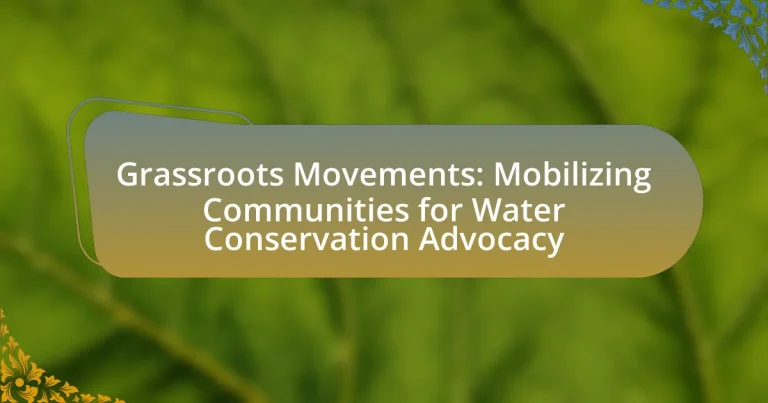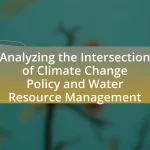Grassroots movements in water conservation advocacy are community-driven initiatives focused on promoting sustainable water management practices. These movements arise from local concerns regarding water scarcity and pollution, mobilizing individuals to engage in collective action. The article explores how grassroots movements effectively mobilize communities through education, advocacy, and local partnerships, highlighting successful examples such as the Waterkeeper Alliance and the Save Our Springs Alliance. It also addresses the challenges these movements face, including limited funding and political support, while emphasizing the importance of community education and participation in achieving significant environmental and legislative changes.
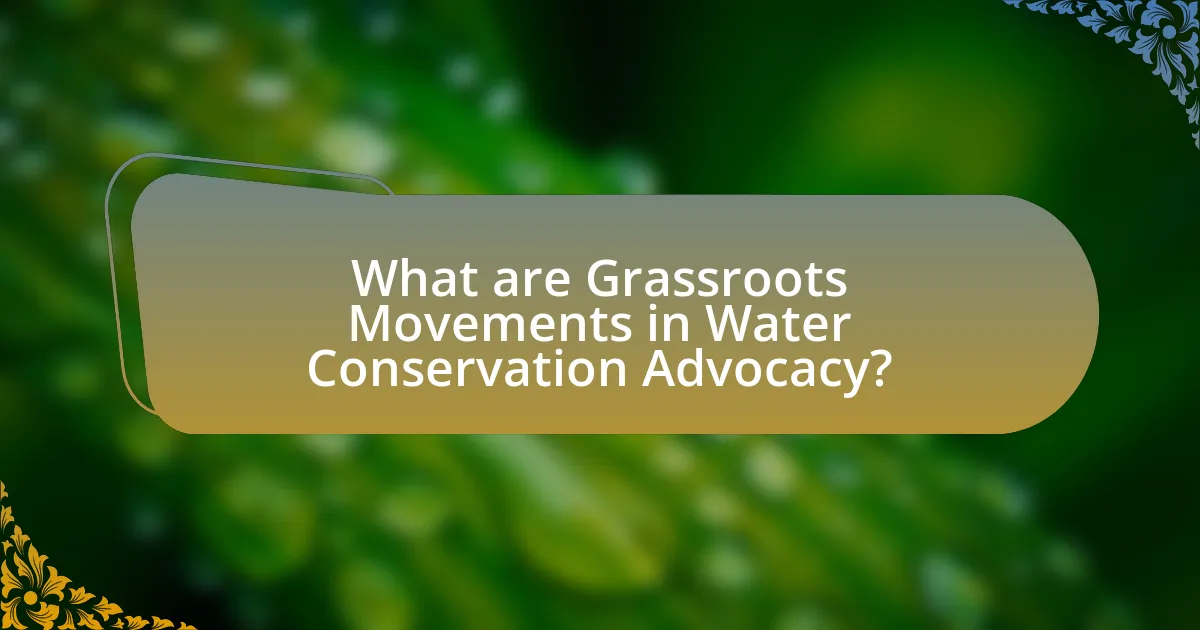
What are Grassroots Movements in Water Conservation Advocacy?
Grassroots movements in water conservation advocacy are community-driven initiatives aimed at promoting sustainable water management practices. These movements often emerge from local concerns about water scarcity, pollution, or mismanagement, mobilizing individuals and groups to take collective action. For instance, organizations like the Waterkeeper Alliance have successfully engaged communities to protect local waterways through grassroots activism, demonstrating the effectiveness of localized efforts in influencing policy and raising awareness. Such movements empower citizens to advocate for their rights to clean water and sustainable practices, often leading to significant environmental and legislative changes.
How do Grassroots Movements mobilize communities for water conservation?
Grassroots movements mobilize communities for water conservation by fostering local engagement and awareness through education, advocacy, and collective action. These movements often utilize community meetings, workshops, and social media campaigns to inform residents about the importance of water conservation and the specific challenges their local water resources face. For example, organizations like the Sierra Club have successfully mobilized communities by providing resources and training on sustainable practices, leading to increased participation in conservation efforts. Additionally, grassroots movements often collaborate with local governments and environmental organizations to amplify their impact, demonstrating that community-driven initiatives can lead to significant improvements in water management and conservation practices.
What strategies do these movements employ to engage local populations?
Grassroots movements employ strategies such as community education, participatory decision-making, and local partnerships to engage local populations in water conservation advocacy. Community education initiatives raise awareness about water issues and conservation techniques, often utilizing workshops and informational campaigns tailored to local contexts. Participatory decision-making involves local residents in the planning and implementation of water conservation projects, ensuring their voices are heard and fostering a sense of ownership. Additionally, forming partnerships with local organizations and stakeholders enhances resource sharing and strengthens community ties, which is crucial for sustained engagement. These strategies have been shown to increase community involvement and effectiveness in conservation efforts, as evidenced by successful case studies in various regions.
How do grassroots leaders influence community participation?
Grassroots leaders influence community participation by fostering trust and building relationships within the community. They engage residents through inclusive dialogue, ensuring that diverse voices are heard and valued. This approach encourages individuals to take ownership of local issues, such as water conservation, by demonstrating the tangible benefits of collective action. Research indicates that communities with strong grassroots leadership experience higher levels of civic engagement and participation in initiatives, as seen in studies conducted by the National Civic League, which highlight the correlation between grassroots efforts and increased community involvement in environmental advocacy.
Why are Grassroots Movements important for water conservation?
Grassroots movements are important for water conservation because they empower local communities to take action and advocate for sustainable water management practices. These movements often arise from the direct experiences and needs of community members, leading to tailored solutions that address specific local water issues. For instance, grassroots initiatives have successfully influenced policy changes, such as the establishment of water protection regulations in various regions, demonstrating their effectiveness in mobilizing community support and raising awareness about water conservation. Additionally, studies show that community-led efforts can lead to increased public engagement and education on water issues, fostering a culture of conservation that is essential for long-term sustainability.
What impact do these movements have on local water policies?
Grassroots movements significantly influence local water policies by advocating for sustainable practices and community engagement. These movements often mobilize residents to demand better water management, leading to policy changes that prioritize conservation and equitable access. For instance, in California, grassroots organizations have successfully pushed for legislation that enhances water efficiency standards and promotes the use of recycled water, demonstrating the tangible impact of community advocacy on local governance.
How do grassroots efforts contribute to sustainable water management?
Grassroots efforts significantly contribute to sustainable water management by fostering community engagement and local stewardship of water resources. These initiatives empower individuals and communities to take action in conserving water, often leading to the implementation of effective local practices such as rainwater harvesting and watershed management. For instance, the grassroots organization “Waterkeeper Alliance” mobilizes local communities to monitor water quality and advocate for pollution reduction, demonstrating the impact of community-led efforts on maintaining clean water sources. Additionally, studies show that community-based water management can lead to more sustainable practices, as local stakeholders are more likely to prioritize long-term ecological health over short-term gains.
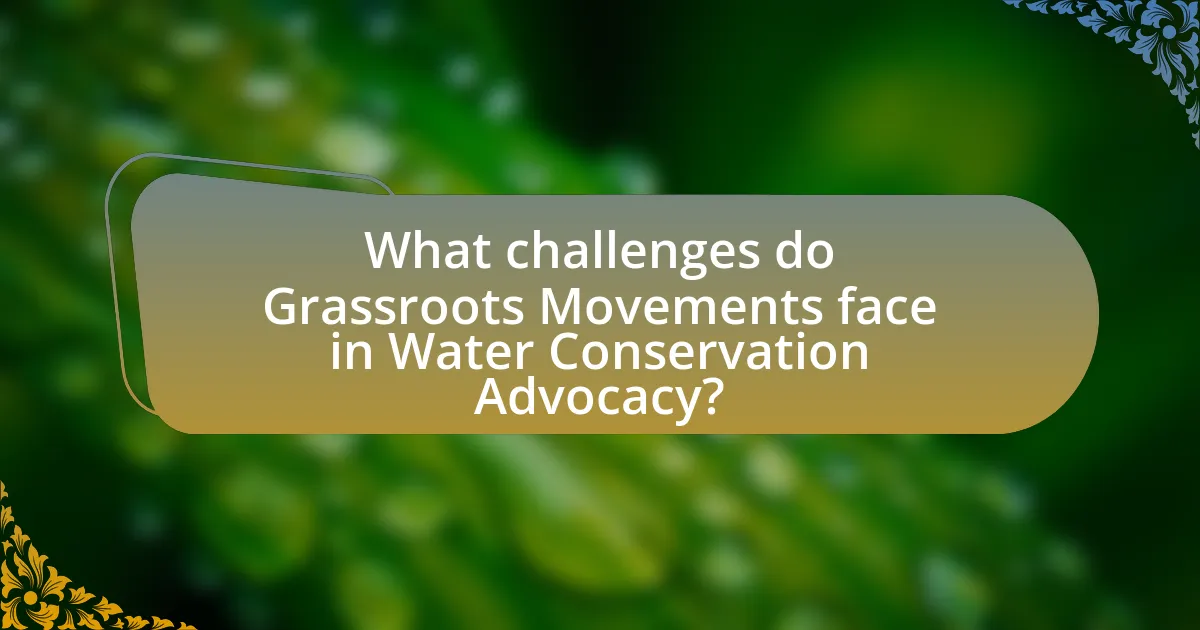
What challenges do Grassroots Movements face in Water Conservation Advocacy?
Grassroots movements face significant challenges in water conservation advocacy, primarily due to limited funding and resources. These movements often rely on volunteer efforts and small donations, which restrict their ability to implement large-scale initiatives or outreach programs. Additionally, they encounter difficulties in gaining political support, as local governments may prioritize economic development over environmental concerns, leading to conflicts of interest. Furthermore, grassroots movements struggle with public awareness and engagement, as many community members may lack understanding of water conservation issues or feel disconnected from the advocacy efforts. According to a study by the Environmental Protection Agency, effective grassroots campaigns require substantial community involvement and education, which can be hindered by these challenges.
How do funding and resources affect grassroots initiatives?
Funding and resources significantly enhance the effectiveness and reach of grassroots initiatives. Adequate financial support allows these movements to organize events, conduct outreach, and implement programs that engage the community in water conservation efforts. For instance, a study by the National Council of Nonprofits indicates that organizations with stable funding are 50% more likely to achieve their goals compared to those without. Additionally, access to resources such as training, materials, and technology empowers grassroots groups to develop innovative solutions and strategies, thereby increasing their impact on local water conservation advocacy.
What are common sources of funding for these movements?
Common sources of funding for grassroots movements focused on water conservation advocacy include individual donations, grants from non-profit organizations, government funding, and corporate sponsorships. Individual donations often come from community members who are passionate about environmental issues, while grants from foundations such as the Water Conservation Fund provide financial support for specific projects. Government funding can be accessed through local, state, or federal programs aimed at promoting sustainable practices. Additionally, corporate sponsorships from businesses interested in enhancing their corporate social responsibility initiatives can also contribute significant resources to these movements.
How can grassroots movements overcome resource limitations?
Grassroots movements can overcome resource limitations by leveraging community engagement and collaboration. By mobilizing local volunteers and fostering partnerships with other organizations, these movements can pool resources, share knowledge, and amplify their impact. For instance, the Waterkeeper Alliance, which focuses on water conservation, demonstrates how grassroots organizations can unite communities to advocate for environmental protection, effectively utilizing limited financial resources through collective action and shared goals. This collaborative approach not only enhances resource availability but also strengthens community ties and increases advocacy effectiveness.
What role does community education play in these movements?
Community education plays a crucial role in grassroots movements for water conservation advocacy by empowering individuals with knowledge and skills necessary for effective participation. This education fosters awareness about water issues, promotes sustainable practices, and encourages community engagement, which are essential for mobilizing collective action. For instance, programs that educate residents about local water resources and conservation techniques have been shown to increase community involvement in water-saving initiatives, leading to measurable reductions in water usage. Studies indicate that communities with strong educational outreach experience higher rates of participation in conservation efforts, demonstrating the direct impact of community education on the success of these movements.
How do educational programs enhance community awareness about water issues?
Educational programs enhance community awareness about water issues by providing targeted information and practical solutions that engage residents in local water conservation efforts. These programs often include workshops, seminars, and hands-on activities that educate participants about the importance of water resources, the impact of pollution, and sustainable practices. For instance, a study by the Water Research Foundation found that communities with educational initiatives saw a 20% increase in water conservation behaviors among residents. By fostering a deeper understanding of water-related challenges, educational programs empower individuals to take action, thereby strengthening community involvement in water conservation advocacy.
What methods are effective for educating diverse community members?
Effective methods for educating diverse community members include culturally relevant programming, interactive workshops, and community partnerships. Culturally relevant programming ensures that educational materials resonate with the specific cultural backgrounds of community members, enhancing engagement and understanding. Interactive workshops facilitate hands-on learning experiences, allowing participants to actively engage with the content, which has been shown to improve retention and application of knowledge. Community partnerships leverage local organizations and leaders to disseminate information, ensuring that outreach is effective and tailored to the community’s unique needs. Research indicates that these methods significantly increase participation and knowledge retention among diverse populations, as evidenced by studies conducted by the American Journal of Community Psychology, which highlight the importance of culturally tailored approaches in educational initiatives.
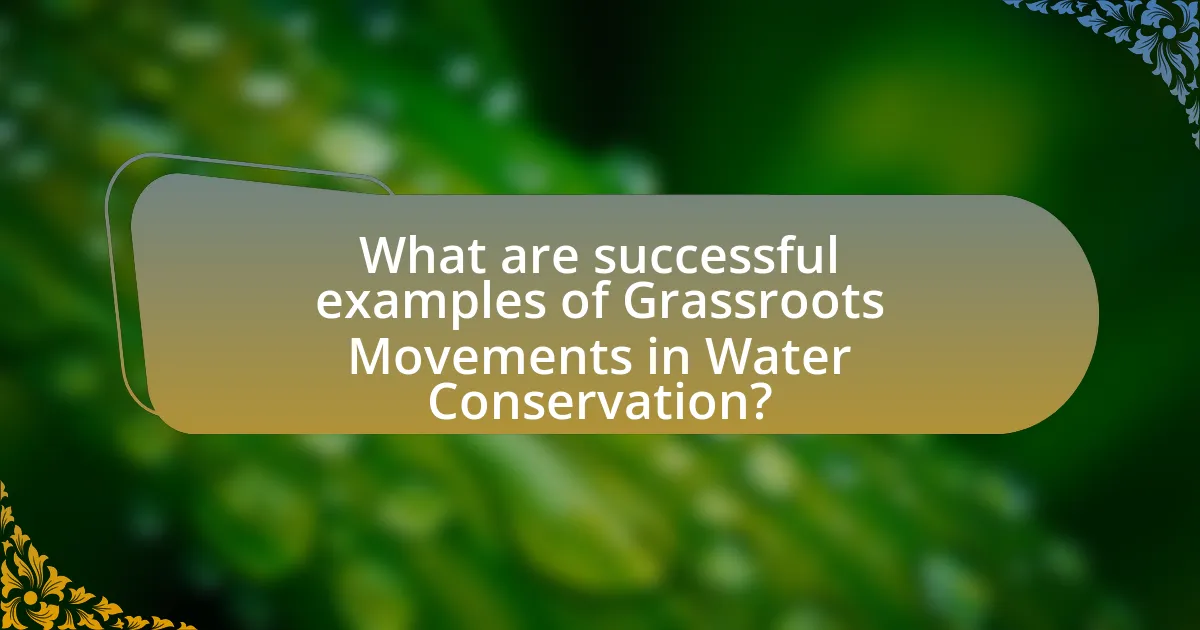
What are successful examples of Grassroots Movements in Water Conservation?
Successful examples of grassroots movements in water conservation include the Save Our Springs Alliance in Texas and the Waterkeeper Alliance, which operates globally. The Save Our Springs Alliance successfully mobilized community efforts to protect the Edwards Aquifer, leading to the establishment of protective regulations and increased public awareness about water quality. The Waterkeeper Alliance, founded in 1999, has over 300 local Waterkeeper organizations advocating for clean water through community engagement and legal action, resulting in significant improvements in water quality in various regions. These movements demonstrate the power of community mobilization in achieving effective water conservation outcomes.
What case studies illustrate effective grassroots advocacy for water conservation?
Case studies illustrating effective grassroots advocacy for water conservation include the “Save Our Springs” campaign in Austin, Texas, and the “Waterkeeper Alliance” initiative. The “Save Our Springs” campaign successfully mobilized local residents to protect the Edwards Aquifer, leading to the establishment of protective ordinances and increased public awareness about water quality. This campaign resulted in significant policy changes, including the creation of the Save Our Springs District, which regulates development in sensitive areas. The “Waterkeeper Alliance,” founded by Robert F. Kennedy Jr., has empowered local communities across the United States to monitor and protect their waterways, leading to numerous legal actions against polluters and the restoration of local water bodies. These case studies demonstrate the power of grassroots movements in influencing water conservation policies and practices.
How did these movements achieve their goals?
Grassroots movements achieved their goals through community engagement, education, and advocacy efforts that mobilized local populations to take action for water conservation. These movements often utilized workshops, social media campaigns, and local events to raise awareness about water issues, leading to increased public participation and support for conservation initiatives. For instance, the “Save Our Water” campaign in California successfully engaged over 1 million residents through educational programs and community events, resulting in significant reductions in water usage during drought periods. This direct involvement of community members not only fostered a sense of ownership over local water resources but also influenced policy changes at municipal and state levels, demonstrating the effectiveness of grassroots advocacy in achieving tangible environmental goals.
What lessons can be learned from their successes and challenges?
Grassroots movements in water conservation advocacy demonstrate that community engagement and local leadership are crucial for success. These movements often succeed by fostering strong relationships among community members, which enhances collective action and accountability. For instance, the success of the “Save Our Water” campaign in California highlighted the importance of localized knowledge and the ability to mobilize residents around shared values and goals. Conversely, challenges such as limited funding and resistance from larger institutions reveal the need for sustainable resources and strategic partnerships. The experience of the “Water Warriors” in India illustrates that overcoming bureaucratic hurdles requires persistent advocacy and innovative solutions. These examples underscore that effective grassroots movements must adapt to their unique contexts while leveraging community strengths to address water conservation challenges.
How can individuals get involved in Grassroots Movements for Water Conservation?
Individuals can get involved in grassroots movements for water conservation by participating in local advocacy groups, attending community meetings, and volunteering for water-related initiatives. These actions allow individuals to collaborate with others who share similar goals, such as reducing water waste and promoting sustainable practices. For example, organizations like the Sierra Club and local watershed groups often organize events and campaigns that require community participation, which can lead to significant local impact. Engaging in these activities not only raises awareness but also fosters a collective effort towards effective water conservation strategies.
What are practical steps for community members to join these initiatives?
Community members can join grassroots water conservation initiatives by participating in local meetings, volunteering for events, and engaging in educational workshops. These actions allow individuals to connect with like-minded individuals and organizations focused on water conservation. For instance, attending community forums or town hall meetings often provides insights into ongoing initiatives and opportunities for involvement. Additionally, volunteering for clean-up events or tree planting days directly contributes to conservation efforts and fosters community engagement. Educational workshops can enhance knowledge about water conservation practices, empowering members to advocate effectively within their communities.
How can individuals advocate for water conservation in their own communities?
Individuals can advocate for water conservation in their communities by organizing local awareness campaigns that educate residents about the importance of water conservation. These campaigns can include workshops, informational flyers, and community meetings that highlight practical water-saving techniques, such as fixing leaks, using water-efficient appliances, and implementing rainwater harvesting systems. Research indicates that community engagement significantly increases the likelihood of adopting water-saving practices; for instance, a study by the American Water Works Association found that communities with active conservation programs reduced water usage by up to 20%. By fostering a culture of conservation through education and community involvement, individuals can effectively promote sustainable water use in their neighborhoods.
